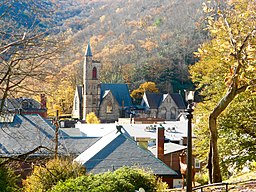Mauch Chunk
| Jim Thorpe, Pennsylvania (Mauch Chunk) | |
| "The Switzerland of America" "The Gateway to the Poconos" |
|
| Borough | |
|
View of St. Marks from the Asa Packer Mansion grounds
|
|
| Country | United States |
|---|---|
| State | Pennsylvania |
| County | Carbon |
| Elevation | 730 ft (222.5 m) |
| Coordinates | 40°52′23″N 75°44′11″W / 40.87306°N 75.73639°WCoordinates: 40°52′23″N 75°44′11″W / 40.87306°N 75.73639°W |
| Area | 14.8 sq mi (38.3 km2) |
| - land | 14.5 sq mi (38 km2) |
| - water | 0.3 sq mi (1 km2), 2.03% |
| Population | 4,781 (2010) |
| Density | 327.5/sq mi (126.4/km2) |
| Founded | 1818 |
| Mayor | Mike Sofranko |
| Timezone | EST (UTC-5) |
| - summer (DST) | EDT (UTC-4) |
| ZIP code | 18229 |
| Area code | 570 Exchange: 325 |
| FIPS code | 42-38200 |
| GNIS ID | 1178082, 1215045 |
|
Location of Jim Thorpe in Carbon County
|
|
|
Location of Pennsylvania in the United States
|
|
|
Website: www |
|
Jim Thorpe is a borough and the county seat of Carbon County in the U.S. state of Pennsylvania. The population was 4,781 at the 2010 census. The town has been called the "Switzerland of America" due to the picturesque scenery, mountainous location, and architecture; as well as the "Gateway to the Poconos." It is in eastern Pennsylvania about 80 miles (130 km) north of Philadelphia and 100 miles (160 km) west of New York City. This town is also historically known for burying the body of Native American sports legend Jim Thorpe.
Jim Thorpe was founded as Mauch Chunk /ˌmɔːk ˈtʃʌŋk/, a name derived from the term Mawsch Unk (Bear Place) in the language of the native Munsee-Lenape Delaware peoples: possibly a reference to Bear Mountain, an extension of Mauch Chunk Ridge that resembled a sleeping bear, or perhaps the original profile of the ridge, which has since been changed heavily by 220 years of mining. The company town was founded by Josiah White and his two partners, founders of the Lehigh Coal & Navigation Company (LC&N). The town would be the lower terminus of a gravity railroad, the Summit Hill & Mauch Chunk Railroad, which would bring coal to the head of the Lehigh Canal for transshipment to the Delaware River, 43 kilometres (26.7 mi) downstream. It would thereby connect LC&N's coal mines to Philadelphia, Trenton, New York City, and other large cities in New Jersey and Delaware, and by ocean to the whole East Coast.
...
Wikipedia




